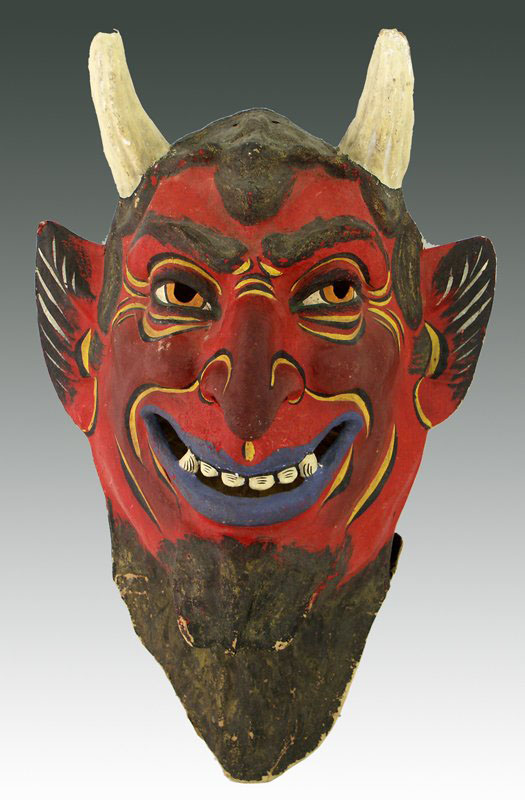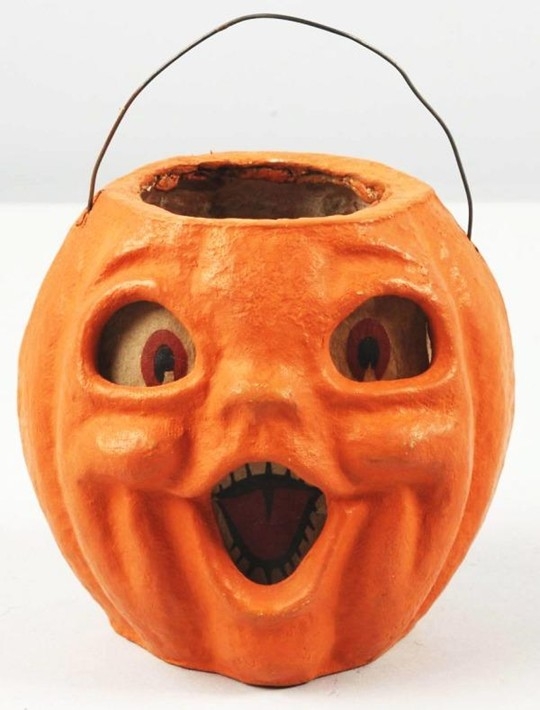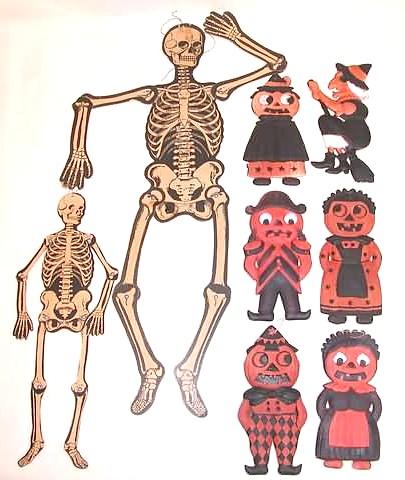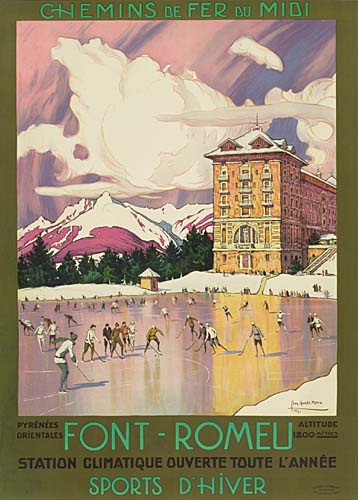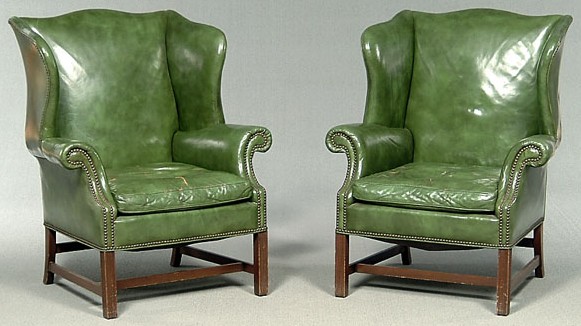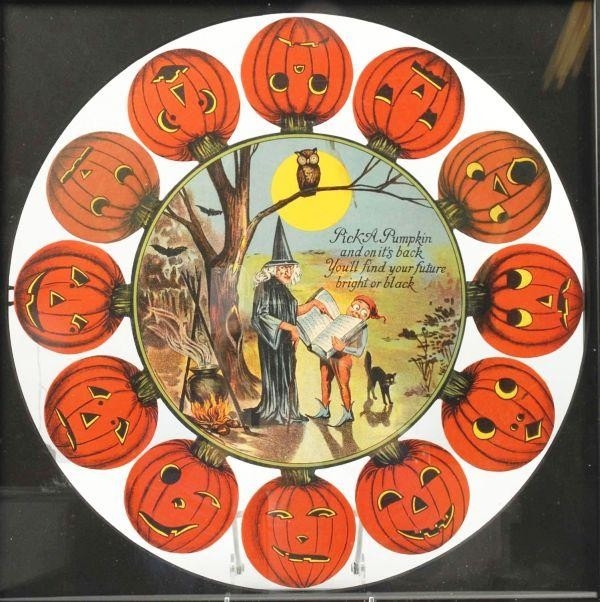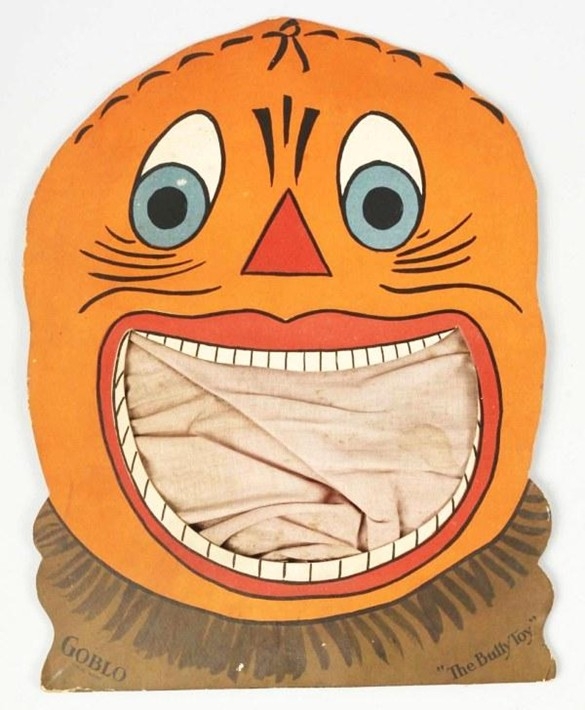One of the most common questions in the antiques marketplace is, “What’s hot right now?” At Prices4Antiques.com, we’re seeing a scary number of searches among our Halloween collectibles. This week, we’ve seen searches for a toy witch riding a motorcycle, the classic jack o’ lantern candy pails, a German papier-mache devil’s mask, a string of jack o’ lantern lights, and another witch, this one traveling by rocket! These items were the ones viewed most frequently in our Halloween section, but, as always, people searched for thousands of other antiques and collectibles at Prices4Antiques.com!
You are currently browsing admin’s articles.
Collectors covet eerie ephemera and delight in a variety of Halloween paper products from the turn of the century and later.
Halloween Lanterns and Shades
Lanterns are some of the earliest of the manufactured Halloween decorations, with U.S. made parade lanterns appearing on the scene between1900-1910. They were made of molded cardboard, composition, tin, or heavy, flat cardboard. Some were equipped with wire hangers, some were made to sit on a flat surface, and others were hinged in the middle with a stick on a base for carrying. Lanterns could be one sided, two-sided with identical sides, or two sided with varying sides, (for example a smiling Jack-o-Lantern and a leering JOL), pyramid shape, or four-sided. Also popular were collapsible lanterns featuring elaborate cut-out scary scenes, paper inserts with as many as twelve sides. Lanterns usually came with inserts of light-weight cardboard or crepe paper thru which the candle light glowed in an eerie manner. Pieces with the inserts intact are a little harder to find. Some lanterns were simply one sheet of cardboard with an attached candle-holder and cardboard stand.
Early lanterns often came with an integral metal candle holder, but when the dangers of candles & cardboard became obvious, manufacturers began producing shades that were designed to hang over light bulbs. Lanterns and shades were manufactured in Germany and in the U.S, by Dolly Toy Company, Beistle, Gibson Art, F.N. Burt, and others.
Halloween Cardboard Diecuts
Diecuts are cardboard decorations that are flat or heavily embossed that were made to hang on a wall or dangle from a string. Particularly popular were the jointed versions, frequently in the guise of skeletons, black cats, and in the late 1920s and early ‘30s creepy beings such as Skairo and Lightning Wumpus, the Hallowe’en Devil.
As with most Halloween decor, the earliest diecuts are the spookiest and most interesting. Malevolent devils, snarling cats and leering Jack-o-lanterns gradually evolved into cutesy critters as Halloween became the child-centered holiday we observe today. Like lanterns and shades, diecuts were made in both the U.S. and Germany. The German versions were often heavily embossed and almost 3-dimensional with handpainted highlights that made them delightfully creepy.
More Collectible Halloween Ephemera
Halloween collectors like just about anything connected with October 31st, and a complete collection will include an almost unlimited variety of paper products. The Dennison Manufacturing Company of Framingham, Massachusetts released Halloween themed products year after year, and is still in business today. Dennison products included crepe paper aprons, table covers, and streamers, and also invitations, gummed seals (lick & stick), nut cups and garland and other creepy collectibles.
-by p4A Contributing Editor Susan Cramer
Reference & Further Recommended Reading:
To search the Prices4Antiques antiques reference database for valuation information on hundreds of thousands of antiques and fine art visit our homepage www.prices4antiques.com
French Poster Art Travels to New Heights
Few collectibles have aged as well as French poster art from early in the last century. After more than a hundred years, the seductive lure of these brightly colored and beautifully drawn posters attract a wide range of collectors including those who can probably afford original art. Vintage posters are a popular segment of the art print collectible area, and of all the poster categories, French travel posters are some of the most eagerly sought.
Signed French Travel Posters
Collectors love posters created by familiar artists of the early 1900s such as Georges Dorival, Constant Duval, Julien Lacaze. Later posters that date from the Art Deco Era featuring the likes of A.M. Cassandre and Roger Broders are also popular. While as a general rule, posters by these identifiable and prolific artists tend to bring the highest sums, dealers caution collectors against buying solely for name, as some of the most highly prized posters are the most beautiful, and were “one-offs” produced by artists whose names rarely appeared again. Collectors should consider each poster on its own merits, and buy for content and condition.
Values of French Travel Posters
Values for travel posters have been rising steadily since the first U.S. poster auction in 1979 at Swann Galleries. At an August 2011 sale of travel and vintage posters at Christie’s, 298 lots sold for a total of $1.27 million.
According to poster expert and dealer, Jack Rennert, the value of a poster is based upon four criteria: artist, subject, rarity and condition. Due to age, small tears and pin holes are common and acceptable, but do bring down the value and collectors prefer examples with the vivid colors of the originals.
Posters set in the south of France fetch premium prices. Collectors love Monte Carlo, Monaco and Nice, especially views with beaches and palm trees. If there are people on the beach, even better, and if the sunbathers include beautiful women, better still. If the poster is of a popular destination and subject with only a few known copies, the price can approach that of original artwork.
Brief History of French Travel Posters
These posters were produced as advertising, not art, and as such, were manufactured with the idea of a limited existence. This limited supply creates high demand, although the posters were popular inexpensive art almost immediately as soon as the multi-color stone lithography process (pioneered by Jean Cheret at the end of the 19th Century) came into widespread use. The popular posters were produced in vibrant colors to advertise everything from cigarettes to champagne, and by the 1890s, railways were plastering their stations throughout France with oversized posters of beautiful people in exotic destinations. Although people collected them almost from the start, two world wars have taken their toll on extant examples.
-by p4A Contributing Editor Susan Cramer.
One of the most common questions in the antiques marketplace is, “What’s hot right now?” At Prices4Antiques, we always see lots of searches for furniture and in the past seven days, we’ve seen searches for a Union National flame-grained veneered dining room suite, a Governor Winthrop slant-lid mahogany desk, a pair of Loeblein reproduction Georgian-style armchairs, a Jacobean oak armchair with triangle seat, and a Phoenix Chair Company Arts & Crafts rocking chair. These were the top five items viewed in our furniture section this week, but people searched for thousands of other antiques and collectibles at Prices4Antiques.com.
Vintage Halloween Games
Once popular with partygoers and now popular with collectors, Halloween party games and score pads are an important segment of the vintage Halloween collectibles market.
Vintage Halloween Tally Cards
In the early part of the century, Halloween was celebrated at parties, typically by adults. They would gather at each others’ homes and play social games like Bridge and Mahjong. Consequently, there is a wide variety of collectibles in the form of tally pads. These pads were used for keeping score and were often elaborately decorated including cut-outs in complex shapes. While many cards were flat or folded, some were much more complicated. Mechanical tally cards were like modern day pop-ups complete with scene changes. Denison made a popular card in 1929-30 that portrayed a witch’s head in a fiery cauldron. When the tab was pulled, the witch disappeared into the brew. Beistle made a three dimensional set with the characters sporting honeycombed crepe paper tutus. Tally cards were mostly made by American manufacturers.
Halloween Fortune Telling Games
Since Halloween in America has always been a holiday whose purpose is pure fun, Halloween games played a major part in any party. There were games of skill, chance, stunts and fortunes. The earliest games were made to be played by adults, which is why the Mystery Witch Answer Game asks questions such as “Will I own a home?” and “Will I become bald?” The fortune wheel featured flaps that folded out and told fortunes. The Crystal Fortunes game by Beistle (1942) featured a numbered spinner. The player’s fortune was read from a poster with a dozen fortunes that corresponded to that number. Also by Beistle, the Halloween Stunt Quiz (1940s) asked questions that today could culminate in lawsuits like “Do I like old people?” and “Am I too fat?”
Vintage Halloween Stunt Games
Stunt games required that the participants complete such tasks as spinning blindfolded, pushing an apple across the floor using only the nose, whistling Yankee Doodle while wearing a sauce pan, or yodeling. The names of the games were as clever as the challenges. One could play Zingo Halloween Fortune & Stunt, I’m a Dumbskull Stunt Game, Owl Tell Your Fortune and Spin-O-Rama.
Vintage Halloween Skill Games
Games of skill were also popular. Partygoers could toss rings or bags in the shape of donuts at witches, Jack-O-Lanterns, and the tails of growling black cats. The Hitchy Witch game (Beistle 1940’s) had a ring on a string that players could hook on the witch’s nose, chin or hat for a variety of scores. Other skills included tongue twisters, drawing and target shooting. As with other Halloween ephemera, the games were meant to be used and discarded. Often the pieces were printed on a single sheet and had to be punched out before use, so finding a complete game is as easy as pushing an apple with your nose.
-by p4A Contributing Editor Susan Cramer
Reference & Further Recommended Reading:
To search the Prices4Antiques antiques reference database for valuation information on hundreds of thousands of antiques and fine art visit our homepage www.prices4antiques.com

